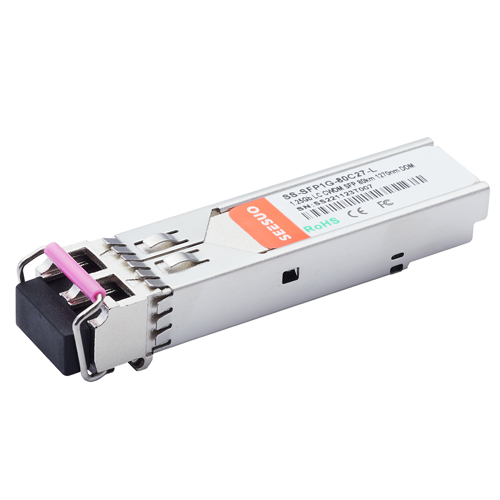- Related articles
- What is 1000BASE Transceiver?
- All Cisco CWDM-SFP-1490's information (List price, Specs, Datasheet PDF, Compatibility mat
- Optical Transceivers for Cisco SF250-48HP-K9-EU Switch
- All Cisco CWDM-SFP-1270's information (List price, Specs, Compatibility matrix)
- Buying guide :What is transceiver and what does it do?
- Optical Transceivers for Cisco SLM2048T-UK Switch
- The Difference between GBIC and X2
- Optical Transceivers for Cisco SLM2016T-UK Switch
- All Cisco CWDM-SFP-1530's information (List price, Specs, Datasheet PDF, Compatibility mat
- All Cisco DWDM-X2-50.12's information (List price, Specs, Datasheet PDF, Compatibility mat

Definition:
The small form-factor pluggable (SFP) is a compact, hot-pluggable transceiver used for both telecommunication and data communications applications. The form factor and electrical interface are specified by a multi-source agreement (MSA) under the auspices of the SFF Committee. It interfaces a network device motherboard (for a switch, router, media converter or similar device) to a fiber optic or copper networking cable. It is a popular industry format jointly developed and supported by many network component vendors. SFP transceivers are designed to support SONET, gigabit Ethernet, Fibre Channel, and other communications standards. Due to its smaller size, SFP obsolesces the formerly ubiquitous gigabit interface converter (GBIC); the SFP is sometimes referred to as a Mini-GBIC. In fact, no device with this name has ever been defined in the MSAs.
What is SFP Port on Switch?
SFP stands for "small form-factor pluggable" and is a hot-swappable input/output device that plugs into a Gigabit Ethernet port or slot, linking the port with the network. SFPs can be used and interchanged on a wide variety of products and can be interchanged in combinations of 1000BASE-SX, 1000BASE-LX/LH, 1000BASE-ZX, or 1000BASE-BX10-D/U on a port-by-port basis. You can use them for Gigabit Ethernet or Fibre Channel applications. They provide a flexible and cost-effective solution for enterprise networks, data centers, etc.
SFP sockets are found in Ethernet switches, routers, firewalls and network interface cards. Storage interface cards, also called HBAs or Fibre Channel storage switches, also make use of these modules, supporting different speeds such as 2Gb, 4Gb, and 8Gb. Because of their low cost, low profile, and ability to provide a connection to different types of optical fiber, SFP provides such equipment with enhanced flexibility.
Conclusion:
SFP interconnects are designed to support applications for 8 Gbps Fibre Channel and 10 Gbps Gigabit Ethernet. SFP interconnects use the same space-per-port as standard SFP interconnects. SFP interconnects are designed to support for 1.125 Gbps Fibre Channel and 2.5 Gbps Gigabit Ethernet applications. In addition to cages, connectors and cable assemblies, Molex offers loopback adapters, light pipe cover assemblies and sealed optical assemblies for both SFP+ and SFP.
The Sealed SFP optical and electrical integrated assemblies are designed to maximize valuable space on the PCB while providing an environmentally rugged interface. Featuring a panel feed-through design, the assemblies incorporate an internally-mounted SFP cage and related electrical circuitry. The SFP transceiver contains a PCB that mates with the SFP electrical connector in the host system.
Please click to check more related concepts:
| Transceivers Package | Ethernet standard | Application | Transceivers Wavelength | Fiber mode |
| SFP+ | 1000Base-X | Bidi | Multi-mode | |
| XFP | 100Base-FX | DWDM | ||
| QSFP+ | 1000BASE-T | WDM | ||
| X2 | ||||
| GBIC | ||||
| CFP | ||||
| CSFP |






































































